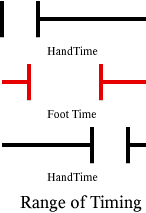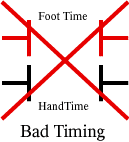As you progress, eventually three things happen:
1) Eventually, offense and defense become one, with coordinated strikes and blocks melding with footwork to become one movement instead of separated movements.
2) Eventually, you progress, after much repetition, from using a techinique to reacting naturally and moving your body and mind as one. In other words, the stepping, blocking, and punching, no matter what style, become a quick natural progression, rather than a catch up situation. You become "sooner" rather than faster or quicker.
3) Lastly, as you progress to the highest levels, there is no distinction!!! No wasted time. And, you stop training, and start practicing. What is the difference in these two terms? Training is the continued repetition of movements until they become innate over time.....nothing mitigates this, and ONLY time makes it happen! Practice is when naturalness takes over, and you are converting your technique into a natural movement, without thought! Practice is understanding what the heck you have learned, and applying it!!!
I hope this helps with your timing question. When doing drills, try at all times to step, block, punch as closely together as possible, and breathe occasionally, you will find that helps as well....LOL!


